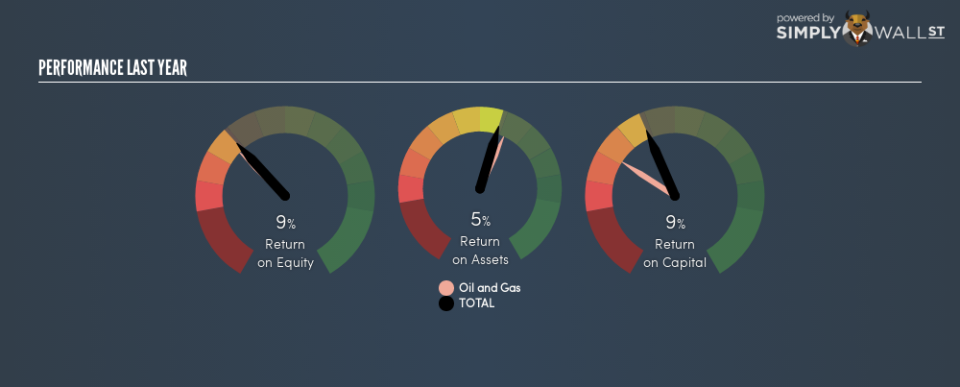Why TOTAL S.A.’s (EPA:FP) Return On Capital Employed Is Impressive

Today we’ll evaluate TOTAL S.A. (EPA:FP) to determine whether it could have potential as an investment idea. To be precise, we’ll consider its Return On Capital Employed (ROCE), as that will inform our view of the quality of the business.
Firstly, we’ll go over how we calculate ROCE. Next, we’ll compare it to others in its industry. And finally, we’ll look at how its current liabilities are impacting its ROCE.
Return On Capital Employed (ROCE): What is it?
ROCE is a metric for evaluating how much pre-tax income (in percentage terms) a company earns on the capital invested in its business. Generally speaking a higher ROCE is better. Ultimately, it is a useful but imperfect metric. Renowned investment researcher Michael Mauboussin has suggested that a high ROCE can indicate that ‘one dollar invested in the company generates value of more than one dollar’.
So, How Do We Calculate ROCE?
The formula for calculating the return on capital employed is:
Return on Capital Employed = Earnings Before Interest and Tax (EBIT) ÷ (Total Assets – Current Liabilities)
Or for TOTAL:
0.092 = US$13b ÷ (US$264b – US$68b) (Based on the trailing twelve months to September 2018.)
So, TOTAL has an ROCE of 9.2%.
See our latest analysis for TOTAL
Want to participate in a short research study? Help shape the future of investing tools and receive a $60 prize!
Is TOTAL’s ROCE Good?
When making comparisons between similar businesses, investors may find ROCE useful. In our analysis, TOTAL’s ROCE is meaningfully higher than the 7.6% average in the Oil and Gas industry. I think that’s good to see, since it implies the company is better than other companies at making the most of its capital. Separate from TOTAL’s performance relative to its industry, its ROCE in absolute terms looks satisfactory, and it may be worth researching in more depth.
In our analysis, TOTAL’s ROCE appears to be 9.2%, compared to 3 years ago, when its ROCE was 5.1%. This makes us think about whether the company has been reinvesting shrewdly.
When considering ROCE, bear in mind that it reflects the past and does not necessarily predict the future. Companies in cyclical industries can be difficult to understand using ROCE, as returns typically look high during boom times, and low during busts. ROCE is, after all, simply a snap shot of a single year. Given the industry it operates in, TOTAL could be considered cyclical. What happens in the future is pretty important for investors, so we have prepared a free report on analyst forecasts for TOTAL.
Do TOTAL’s Current Liabilities Skew Its ROCE?
Current liabilities include invoices, such as supplier payments, short-term debt, or a tax bill, that need to be paid within 12 months. Due to the way the ROCE equation works, having large bills due in the near term can make it look as though a company has less capital employed, and thus a higher ROCE than usual. To check the impact of this, we calculate if a company has high current liabilities relative to its total assets.
TOTAL has total assets of US$264b and current liabilities of US$68b. As a result, its current liabilities are equal to approximately 26% of its total assets. A fairly low level of current liabilities is not influencing the ROCE too much.
What We Can Learn From TOTAL’s ROCE
This is good to see, and with a sound ROCE, TOTAL could be worth a closer look. But note: TOTAL may not be the best stock to buy. So take a peek at this free list of interesting companies with strong recent earnings growth (and a P/E ratio below 20).
If you are like me, then you will not want to miss this free list of growing companies that insiders are buying.
To help readers see past the short term volatility of the financial market, we aim to bring you a long-term focused research analysis purely driven by fundamental data. Note that our analysis does not factor in the latest price-sensitive company announcements.
The author is an independent contributor and at the time of publication had no position in the stocks mentioned. For errors that warrant correction please contact the editor at editorial-team@simplywallst.com.

